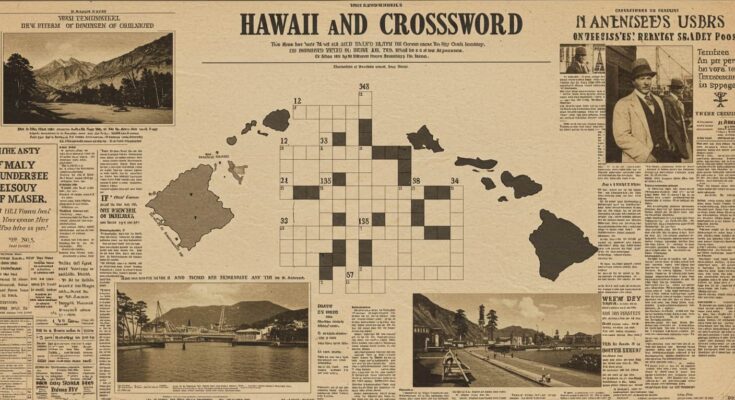Introduction
For many years, puzzle fans all across the world have used the New York Times Crossword as a daily mental exercise.But occasionally, a particular clue ignites conversation, debate, and in some cases—total confusion. One such head-scratcher appeared in a recent NYT mini crossword, centered around the phrase “Hawaii and Tennessee NYT crossword”. This seemingly simple clue left many scratching their heads, searching for connections between two geographically and culturally distinct U.S. states. So, what made this clue so perplexing? Let’s dive into the mechanics behind it and why it resonated (or baffled) so many.
Understanding the Clue: Context Matters
The Daily Mini Format
Unlike the full-sized puzzles that can span a Sunday afternoon, the NYT Mini Crossword is a quick, five-minute brain teaser. Its brevity means each clue must be packed with precision and creativity. That brevity is exactly what made the “Hawaii and Tennessee” clue so potent. With limited words to work with, clue writers rely on ambiguity and double meanings. As a result, many solvers overthought it, only to find the answer deceptively simple.
The Unexpected Answer: “TRIVIA”
The correct answer to the “Hawaii and Tennessee” NYT crossword clue was “TRIVIA”. On its face, this may seem disconnected. What could these two states possibly have in common that links to the word “trivia”? This question led solvers down various rabbit holes until they discovered the subtle but clever connection.
The Hidden Connection Between Hawaii and Tennessee
Double Letters in State Names
The key lies in a fun fact: both Hawaii and Tennessee are among the few U.S. states with double letters in their names. Hawaii has double I’s, and Tennessee has double N’s and double S’s. This quirky feature isn’t about geography or culture—it’s about orthography. It’s the kind of detail that doesn’t matter much in day-to-day life but fits perfectly in the world of crossword puzzles and trivia.
Beyond Geography: A Linguistic Connection
While geography and culture often dominate crossword clues, this one leaned into linguistics. The shared feature isn’t about borders or history—it’s about how the state names are spelled. It’s an excellent example of how language patterns, not just meaning, can form the basis of a crossword clue. By shifting focus from meaning to form, the clue challenged players to think from a completely different angle.
A Classic Example of Crossword Trickery
Trivia as Misdirection
This type of clue is a classic example of trivia used as a misdirection tactic. Solvers often try to find deep or thematic connections—shared historical significance, cultural touchpoints, or even musical heritage. Instead, the answer is simply that these states contain double letters, making it a fun linguistic nugget rather than a thematic one. This redirection from assumed depth to surface-level oddity is a hallmark of great puzzle design.
The Art of the Red Herring
This clue works because it leads solvers to overanalyze. Red herrings are commonly used by crossword constructors to make solvers think in one direction, only to find the answer lies elsewhere entirely. In this instance, the proper nouns act as the bait, while the real connection—the spelling—lurks quietly beneath the surface.
Why the Clue Went Viral
Crossword Communities React
After the puzzle dropped, forums like Reddit’s r/crossword and Twitter/X lit up with reactions. Many users expressed surprise or amusement, while others were annoyed at being stumped by such a seemingly trivial clue (pun intended). The collective response created a shared moment of curiosity and, for some, mild frustration.
Social Media Shares and Memes
Some solvers even turned to meme culture to express their frustration, which helped the clue gain traction online. Humor, confusion, and community combined to amplify its visibility. Memes poked fun at how simple the answer was in hindsight, reinforcing how even clever people can be delightfully fooled by a good puzzle.
Cognitive Bias and Overthinking
Humans tend to seek patterns, and many crossword solvers are conditioned to overanalyze. Even seasoned players found “TRIVIA” surprising in its simplicity. The clue succeeded precisely because it broke away from predictable patterns, using the Hawaii and Tennessee NYT crossword combination as a form of lateral thinking. Instead of thinking what those states represent, solvers needed to consider how they are spelled..
Crossword Design Philosophy
Misdirection with Minimal Clues
NYT puzzle creators are masters of misdirection. In a full crossword, solvers can cross-check answers using intersecting clues. But the Mini Crossword doesn’t afford that luxury. Each clue must stand on its own, making minimalism a powerful tool. The fewer the words, the greater the chance for layered meanings.
The Role of Trivia in Puzzle Culture
Trivia isn’t just filler. It often serves as the intellectual glue that binds seemingly unrelated clues together. Clues like “Hawaii and Tennessee” become not just tests of knowledge but reflections of how solvers think and interpret. In that way, trivia reinforces both the learning and playful aspects of crosswords.
Solver Strategies: How to Avoid Getting Stumped
Recognize Red Herrings
When a clue names proper nouns like states or countries, solvers often go looking for cultural or historical connections. Develop the ability to think about language peculiarities as well. Sometimes what appears to be thematic is actually mechanical.
Practice with Trivia-Based Clues
The more you familiarize yourself with trivia and fun facts, the easier these puzzles become. Try engaging with trivia games or quizzes to broaden your knowledge. Websites and apps dedicated to general trivia can double as crossword prep.
Think Literally and Laterally
Don’t always assume the clue is metaphorical or abstract. Sometimes, a clue really is just about letter patterns, wordplay, or simple fun facts. Developing both literal and lateral thinking skills is key to mastering Mini Crosswords.
FAQs Regarding the Clue for the “Hawaii and Tennessee NYT Crossword”
What was the answer to the Hawaii and Tennessee NYT crossword clue?
The answer was “TRIVIA”, referencing a fun fact that both states have double letters in their names.
Why did the clue confuse so many solvers?
Most solvers were expecting a thematic or geographic link, but the answer relied on an obscure language fact—the presence of double letters. That’s why it came off as tricky and clever.
Are there other states with double letters?
Yes! Others include Mississippi (double S and double P), Missouri (double S), and Connecticut (double N and double C), among others.
How common are trivia-based clues in NYT crosswords?
They’re more common than you think, especially in Mini Crosswords where space is limited and each clue has to pack a punch. Trivia clues offer an efficient way to mislead and delight solvers.
What makes NYT Mini Crossword clues unique?
They are particularly difficult and captivating because of their succinctness, deft wordplay, and capacity to shock solvers with surprising solutions.
The Bigger Picture: Cultural Relevance of Crosswords
Micro-Puzzles, Macro-Engagement
Mini crosswords have surged in popularity because they offer a satisfying challenge in a short amount of time. Clues like “Hawaii and Tennessee” exemplify how small puzzles can still create big conversations. These moments turn a casual hobby into a trending topic.
Word Games’ Ascent in the Digital Age
Games like Wordle, Spelling Bee, and the Mini Crossword have shown that word games are more social than ever. The sharing of surprising answers adds a layer of communal discovery. These platforms make puzzling part of daily digital culture.
Education Through Entertainment
Even when stumped, solvers walk away having learned something. That’s the enduring magic of the NYT crossword ecosystem. It teaches, it teases, and it ultimately rewards curiosity.
Final Thoughts: What We Can Learn
The “Hawaii and Tennessee NYT crossword” clue may have stumped many, but it also taught an important lesson: sometimes the simplest clues are the most complex. It reinforced the value of thinking outside the box and showcased how trivia, often overlooked, plays a vital role in puzzle construction.
Whether you’re a seasoned cruciverbalist or a casual solver, clues like this are a reminder that puzzles are as much about how we think as what we know.



